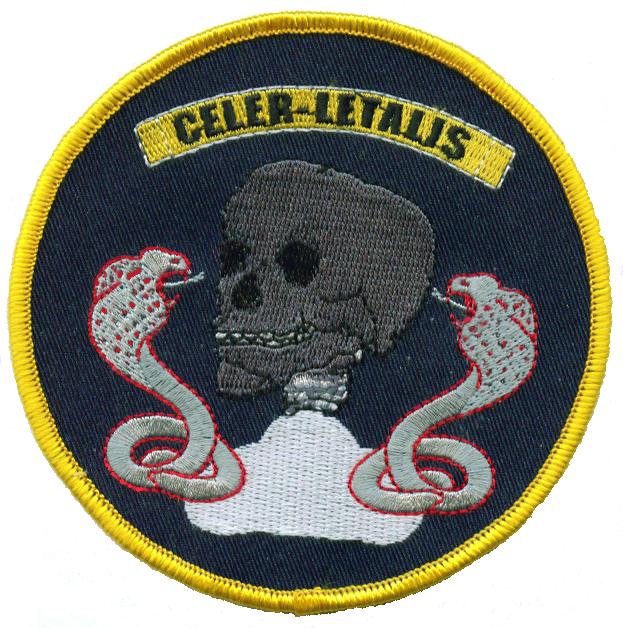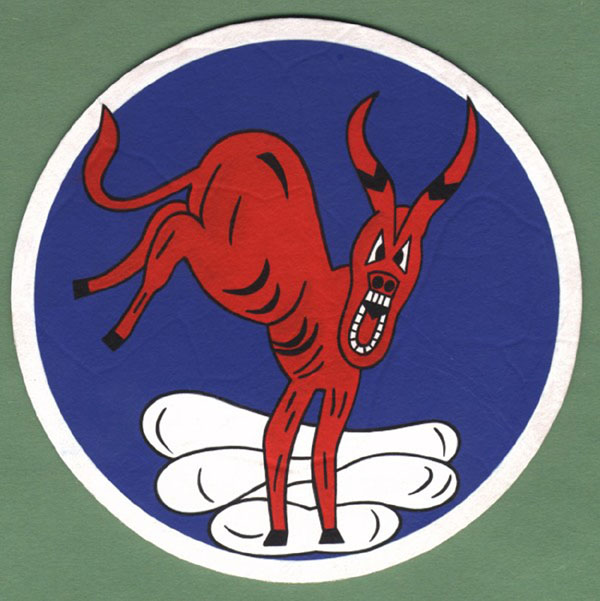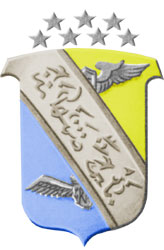
350th Fighter Group
Original Motto "Boldness and Vigor"
Post WW II Motto "In Common Cause"
| Squadron Insignia: | 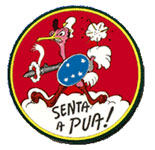 |
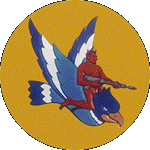 |
|||||
| 1st Brazilian Sq |
345th FS: 'Devil Hawks' |
346th FS: Shuford M "Big Al" Alexander designed the Logo for the squadron. This was Goofy, with flak bursting all around him, sweating blood while flying a plane made from a whiskey barrel and C-ration crates, with a pop gun (firing a cork) as the gun and an umbrella on the side for a parachute | 347th FS: 'Screaming Red Ass Squadron' 347th logo as created by George Faltum and approved by then CO Major Francis Grable. Squadron artist Ted Gurney is credited with later enhancing the design used on the P-47 cowls by adding a second set of yellow lightning bolts. |
||||
| Call Signs | Jambock | Lifetime | Minefield | Midwood | |||
|
Plane Identification codes, P-39 markings: |
2 digit No. on doors | Below is the patch worn by 346th FS while they flew the P-39
Airacobra they used Alphabet Letter, on doors for identification
|
Second variation of the 347th kicking mule design
used Alphabet Letter, on nose for planes identification
|
||||
| P-47 markings: | A (Flt)
1 (A/C No) A 2 A 3 B 2 C 3 D 4... [on Nose] |
5
(Sq) A (Flt)
1 (A/c No) 5 B 2 5 C 3 5 D 4... [on Fuselage] |
6
A 2 |
7 A 3 7 B 4 7 C 5 7 D 6... [on Fuselage] |
| Aircraft Flown: | Spitfire (while in England, awaiting P-39s) | |
| P-39L, N, Q models | ||
| P-39-400 (1941 export model) | ||
| P-38 | ||
| P-47D razor back and bubble canopy models | ||
| Stations | ||||||||||||||||||||||||||||||||||||||||||||||||||||||||||||||||||||||||||||||||||||||
|
||||||||||||||||||||||||||||||||||||||||||||||||||||||||||||||||||||||||||||||||||||||
Following from: http://www.web-birds.com/12th/350/350th.htm
and 50th Fighter Group/347th Fighter Squadron: Forum
The decision to invade North Africa in November 1942 was not made until the middle of August, 1942. Forces available for this difficult operation were minimal—it becoming necessary for the USAAF Eighth Air Force to withdraw most of the combat groups that had reached England by that time from an embryonic bombing campaign over Europe to take part in the battle for control of Northwest Africa.
Export versions of the P-39 originally ordered for the French Air Force in early 1940 had, after the fall of France in May 1940, been sent in several shipments to the RAF beginning in early 1941 to augment the RAF’s fighter force after the Battle of Britain. However, after Hitler turned his attention to the East, the pressure was off the RAF and it had fielded only one P-39 unit (601Sq) in 1941. The other P-39s remained in storage in the crates in which they had arrived. At the same time, by the summer of 1942 the number of American pilot volunteers in the RAF serving in England had grown to a few hundred in number. In urgent need of additional fighters to support the forthcoming invasion, American planners decided to combine these two assets already in England and at the end of September 1942 the American pilots in the RAF were invited to transfer to the USAAF. On 1 October, a number of pilots from the USAAF 31st and 52nd Fighter Groups, who had flown P-39s in the US prior to there arrival in England in June of 42, were ordered to report to RAF Station Duxford England to help activate a new Group, designated as the 350th Fighter Group with three subordinate Squadrons, the 345th, 346th and 347th . (The American Eagle Squadrons were re-designated the 4th Fighter Group about this time but the 350th was the only Group activated from scratch in Europe, in WW II). At the same time, some of the American pilots who had just transferred from the RAF were ordered to the new Group to make up the other half of the original aircrew roster. Although the pilots were not advised of their mission at the time, for security reasons, the plan was for the Group to fly to North Africa six weeks after activation, which was one week after the scheduled invasion of North Africa on 8 November, 1942. The ex RAF pilots had been flying Hurricanes or Spitfires while the ex 31st and 52nd Group pilots had been flying RAF Spitfires with which they had been equipped on their arrival in England, 4 months earlier. As it turned out, the RAF Depot responsible for supporting the operation was completely over committed and could not uncrate and assemble the Group’s P-39 aircraft in time to meet the invasion plan. Airacobras did finally begin arriving in numbers, in mid December, and two weeks later the pilots began flying to North Africa. In the middle of the English winter, many of the ex RAF pilots managed to acquire only some 20 hours of flying time in the new aircraft type by the time they launched for Africa.
The Group’s 75
pilots flew their P-39Ls (346 Sq) and P-39-400 (345 Sq and 347 Sq) fighters
from RAF Stations Portreath and Predannack, on Land-Ends, England, to Port
Lyautey, French Morocco, during the period 3 Jan to 28 Feb 1943. Sixty
one arrived at the destination airfield. Ten pilots that encountered
head winds, instead of the forecast tail wind (the only fuel reserve on the
1200 mile, six to seven hour over water flight) were forced to land in
Portugal where they were interned. One more landed in Portugal after
losing all electrical systems. One flight that broke up in a severe line
squall over the Bay of Biscay lost one pilot, (KIA)—he was flying
alone, probably still on the deck, at max range cruise settings (165 to
175 MPH), when he was likely ambushed, and was shot down by a
patrolling Ju-88 pilot of KG-40 who claimed the kill; one pilot,
after closing on the French coast to determine his location, ended up short of
fuel and crash landed in Spain , where he was interned; another
pilot on that flight became lost and crash landed in Ireland while
attempting to return to England. (http://www.armyairforces.com/forum/m_85813/mpage_1/tm.htm,
Lt. Charles M.
Kirschner, 346 Fighter Squadron, ex RCAF/RAF, did crash land on the southern
part of Ireland, on 5 February 1943. He was part of a five ship P-39
flight that took off from RAF Station Predannack, on Lands End, with
destination Port Lyautey, French Morocco, following a B-25. Out over the
Bay of Biscay they ran into a severe line squall and the flight broke up while
attempting to penetrate. Two of the pilots, Lt. Duket of Hq. 350 Gp and
Lt. Tedford of 345 Sq. rejoined after penetrating the front and made it to
destination. One 347 Sq. pilot, Lt. Clyde Wilson, flew east to establish
his position, encountered the coast of France and turned out to sea again,
before heading south. While over Spain he decided he no longer had
enough fuel to reach French Morocco and chose to crash land on a small Spanish
airfield. After a couple of months the diplomats worked out the details
and he was permitted to proceed to Gibraltar, under cover, and rejoined his
Squadron in Africa. Another pilot in the flight, Lt. Henry M. Nelson,
apparently got through the front and continued south towards his destination.
He was spotted by Lt. Hermann Horstmann who was patrolling over the Bay as a
member of KG/40, in a fighter version of the Ju-88, looking for lone allied
aircraft to intercept. It is assumed that Nelson was still flying near
the deck at maximum range cruise speed—about 165 MPH—when he was
intercepted from behind by Horstmann and was shot down and killed. (See
Chris Goss’s “Bloody Biscay” for further details) The fifth pilot in the
flight, Kirschner, decided to return to England when the flight broke up in
the weather front. He found a hole to let down through over a green
countryside but could not establish his position and after burning up most of
his fuel crash landed in southern Ireland, not knowing till afterward that he
had landed there instead of England. He was released a couple of days
later at the border with Northern Ireland.
One more pilot, Capt. Robert L. English, made a
precautionary landing at Lisbon on the 8th after loosing all electrical
systems. These losses, combined with the major loss of 10 345 Sq.
aircraft an pilots that landed at Lisbon on 15 January 43 when they ran short
of fuel after dodging frontal storms, accounted for the fourteen (out of 75
aircraft) 350th Group losses during the move during the middle of winter, by
many pilots with only 20 hours in the P-39, from England to Africa. The
last flight by the Group’s pilots took place on 28 February 43. )
The first elements of the Air Echelon , and the Ground Echelon, finally joined each other at Oujda, French Morocco, a few days after their arrival in North Africa on 3 January 1943. The Ground Echelon had arrived off North Africa in the first week of November 1942 from the USA with the Operation “Torch” invasion fleet.
The Group began air defense operations along the North African coast a few days after its ground and air elements came together. One month after its first flight arrived in Africa it began its first offensive combat missions, over Tunisia.
The Group flew air defense and fighter- bomber missions with its P-39s and primarily fighter bomber missions with its P-47s. Also, from June to Sept 1943 each Squadron was assigned two P-38s to intercept and destroy high flying Luftwaffe reconnaissance aircraft sent to photograph the allied invasion fleet gathering along the North African coast for the invasion of Sicily. The First Brazilian Fighter Squadron joined the 350th Group as a fourth Squadron in October 1944. The Group’s American Squadrons flew over 37,000 sorties during the war, some 16,600 defensive and more than 20,000 offensive sorties. The 1st Brazilian Fighter Squadron flew an additional 2,546 offensive sorties. Of the totals, most of the defensive sorties were flown in the P-39 Airacobras and P-38 Lightnings while most of its offensive sorties were flown in the P-47 Thunderbolts. However, some 3,850 offensive sorties , from strafing and bombing attacks to fighter sweeps and a few bomber escort missions were flown in the P-39s, while some 700 defensive sorties were flown in the Group’s P-47s.
The Group lost 95 pilots, KIA or killed in flying accidents, eight of these being Brazilian pilots. Twenty two pilots became POWs, 5 of whom were Brazilians. Another 25 pilots were downed on offensive missions but either evaded capture in enemy territory, or, bailed out over or crashed landed on, allied territory; five of these being Brazilian pilots. At least 16 pilots were wounded in action but managed to land at home base or on another allied airfield. Three of these were Brazilian pilots. Thirteen pilots were interned in ‘neutral’ countries. All were permitted to proceed (incognito, in civilian clothes) to Gibraltar, some three months later. Approximately one third of all the American pilots who served in the Group fell into one of the above categories. Approximately 44 percent of the Brazilian pilots who flew missions fell into one of the above categories. However, the Group’s pilots were able to return and land with flak damaged aircraft on almost seven hundred occasions. On the other side of the ledger, the Group’s pilots dropped over 7,000 tons of bombs and fired over 30 million rounds of ammunition in the destruction of enemy targets.
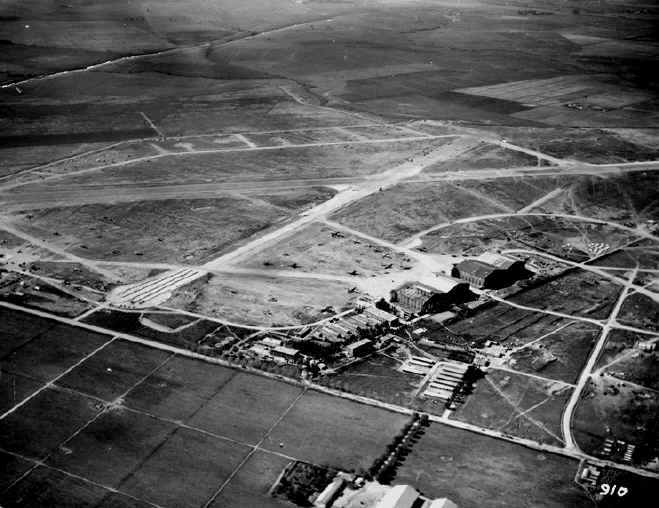
Maison Blanche Project 914 Archives (Steve O. Reno collection)
| Air Forces Assigned To: | 8th AF (Oct '42 - Jan'43) | |
| 12th AF (Jan '43 - – July 45 ) | ||
| Sailed from Italy for Pacific Theater of War, 1 Aug 45, Enroute at End of WWII | ||
|
Activated in England (Air Echelon): |
Bushey Hall, England, 1 Oct 1942 | |
|
And in USA (Ground Echelon) Harding Army Airfield, Baton Rouge Louisiana |
||
| Stations from
which Squadrons of the 350th Group conducted fighter operations: |
RAF Station Duxford, England, HQ. 350 Group and 345th Squadron, Oct 1942 - Jan '43 THURSDAY, 1 OCTOBER 1942, EUROPEAN THEATER OF OPERATIONS (ETO) Eighth Air Force: HQ 350th Fighter Group and the 345th, 346th and 347th Fighter Squadrons are activated at Bushey Hall, England; the ground echelons of the squadrons are at Harding Field, Louisiana and will sail to North Africa for the invasion. THURSDAY, 15 OCTOBER 1942, EUROPEAN THEATER OF OPERATIONS (ETO) Eighth Air Force: HQ 350th Fighter Group and the 345th, 346th and 347th Fighter Squadrons move from Bushey Hall to Duxford, England where they equip with P-39s and P-400s |
|
| RAF Station Coltishall, England, 346th Squadron, Oct 1942 - Jan '43 | ||
| (No combat Ops were flown in England) |
RAF Station Snailwell, England, 347th Squadron , Oct 1942 - Nov '43 SUNDAY, 4 OCTOBER 1942, EUROPEAN THEATER OF OPERATIONS (ETO) Eighth Air Force: The 347th Fighter Squadron, 350th Fighter Group, moves from Bushey Hall to Snailwell, England with P-39s and P-400s. |
|
| RAF Station Kingscliffe, England, 347 Squadron, Dec 1942 | ||
| RAF Station Bassingbourne, England, 347th Squadron, Jan-Feb 1943 | ||
|
Oujda, French Morocco, Jan 1943 THURSDAY, 19 NOVEMBER 1942, NW AFRICA (Twelfth Air Force): In French Morocco, the 345th and 346th Fighter Squadrons, 350th Fighter Group, arrive at Casablanca, the air echelon from the UK with P-39s and P-400s and the ground echelon from the US WEDNESDAY, 6 JANUARY 1943, WESTERN MEDITERRANEAN (Twelfth Air Force):, HQ 350th Fighter Group and its 347th Fighter Squadron with P-39s and P-400s is established at Oujda, French Morocco upon arrival from England. The group's 346th Fighter Squadron, which has been in French Morocco with P-39s and P-400s since Nov 42, also moves to Oujda. The 346th enters combat in Jan 43. WEDNESDAY, 6 JANUARY 1943, WESTERN MEDITERRANEAN (Twelfth Air Force): The 345th Fighter Squadron, 350th Fighter Group with P-39s and P-400s transfers from Casablanca, French Morocco to Oujda, French Morocco. |
||
|
Oran/La Senia, Algeria, Jan - Feb 1943 FRIDAY, 12 FEBRUARY 1943, The 347th Fighter Squadron, 350th Fighter Group with P-39s and P-400s transfers from Oujda, French Morocco to La Senia, Algeria. SUNDAY, 14 FEBRUARY 1943, HQ 350th Fighter Group transfers from Oujda, French Morocco to Oran, Algeria. The group's 345th and 346th Fighter Squadrons with P-39s and P-400s transfer from Oujda to La Senia, Algeria. |
||
| Feriana/Thelepte II landing ground, Tunisia, Feb 1943 | ||
|
Orleansville/Warnier field, Algeria, March - April 43 TUESDAY, 9 MARCH 1943, The 347th Fighter Squadron, 350th Fighter Group with P-39s transfers from La Senia, Algeria to Orleansville, Algeria. WEDNESDAY, 21 APRIL 1943, The 346th and 347th Fighter Squadrons, 350th Fighter Group with P-39's swap bases; the 346th moves from La Senia, Algeria to Orleansville, Algeria; the 347th moves from Orleansville to Le Sers, Tunisia. |
||
|
Le Sers, Tunisia, April-May 43 WEDNESDAY, 21 APRIL 1943, the 347th moves from Orleansville to Le Sers, Tunisia. FRIDAY, 14 MAY 1943, WESTERN MEDITERRANEAN (Northwest African Air Force), The 307th Fighter Squadron, 31st Fighter Group, with Spitfires, transfers from Le Sers, Tunisia to Korba, Tunisia. |
||
|
Maison Blanche, Algeria, May- July 1943 SUNDAY, 16 MAY 1943, WESTERN MEDITERRANEAN (Northwest African Air Force), HQ 350th Fighter Group transfers from Oran, Algeria to Maison Blanche, Algeria. It's 345th Fighter Squadron (P-39's) transfers from La Senia, Algeria to Maison Blanche, Algeria. SATURDAY, 22 MAY 1943, WESTERN MEDITERRANEAN (Northwest African Air Force), The 346th Fighter Squadron, 350th Fighter Group transfers with P-39's from Orleansville, Algeria to Maison Blanche, Algeria. |
||
| Djidjelli/Taher, Algeria, Algeria, May-Dec 1943 | ||
|
Monistir, Tunisia, June 43 FRIDAY, 4 JUNE 1943, WESTERN MEDITERRANEAN (Northwest African Air Force), The 346th Fighter Squadron, 350th Fighter Group based at Maison Blanche, Algeria begins operating it's P-39's from Monastir, Tunisia. SUNDAY, 13 JUNE 1943, WESTERN MEDITERRANEAN (Northwest African Air Force), The 346th Fighter Squadron, 350th Fighter Group which has been operating it's P-39's from Monastir, Tunisia since 4 Jun returns to it's base at Maison Blanche, Algeria. |
||
|
Bone/Tingley, Algeria, July 43 MONDAY, 28 JUNE 1943, WESTERN MEDITERRANEAN (Northwest African Air Force), The 345th Fighter Squadron, 350th Fighter Group transfers with P-39's from Maison Blanche, Algeria to Bone, Algeria. |
||
|
Reghaia, Algeria, Jul 1943-Oct 1943 SATURDAY, 17 JULY 1943, WESTERN MEDITERRANEAN (Northwest African Air Force), HQ 350th Fighter Group and it's 345th Fighter Squadron transfer with P-39's from Maison Blance, Algeria to Rerhaia, Algeria. |
||
| Cagliari/ Elmas, Sardinia, Nov 1943 – June 44 | ||
| Alghero/Fertilla, Sardinia, Nov 43-Aug 44 | ||
| Ghisonaccia, Corsica, Jan 44-May 44 | ||
| Naples/Capodichino, Italy, Feb-Mar 44 | ||
| Tunis/Sidi Amor, Tunisia, Feb-Jun 44 | ||
| Aghione, Corsica, May- July44 | ||
| Naples/Pomigliano, Italy, June-Aug 44 | ||
| Anzio/Tre Concello, Italy, June 44 | ||
| Ajaccio/Compo del Ora, Corsica, July-Sep44 | ||
| Tarquinia, Italy, June –Dec 1944 | ||
| Piombino, Italy, July-Aug 44 | ||
| Livorno/Rosignano, Italy, Aug-Sep 44 | ||
| Pisa, Italy, Dec 1944- Jul 1945 | ||
|
The Group moved to the Port of Embarkation at
Naples, Italy on 14 July 45 and sailed for combat operations |
||
| Awards Won: | Distinguished Unit Citation: Italy, 6 Apr 1944 | |
| Campaigns Flown in: | Air Combat EAME Theatre | |
| Tunisia | ||
| Sicily | ||
| Naples-Foggia | ||
| Rome-Arno | ||
| Southern France | ||
| North Apennines | ||
| Po Valley | ||
| Victory Claims : | Destroyed: | Probable: | Damaged: | |||
| (in Air) | 50 | 9 | 24 | |||
|
(Ground) |
108 | 2 | 72 | |||
Home] [Nominal Roll 1940-45] [March Of The Gladiators] [Gladiators] [K Flight] [112 Sqdn Personnel] [Claims] [Bases 1939-1946 ] [Bill Barwick] [Plane Losses 1940 -45] [Prisoner of War] [In Memory of] [Operations Room Book] [ Log Book Extracts] [112 Plane Codes] [Memories] [Letters Home] [RAF Map Napoli 40/14] [[Allied Air Forces in MTO 1942/43]] [USAAF Honor Rolls 1942-1943 MTO] [US Dispatches] [Photos ]
